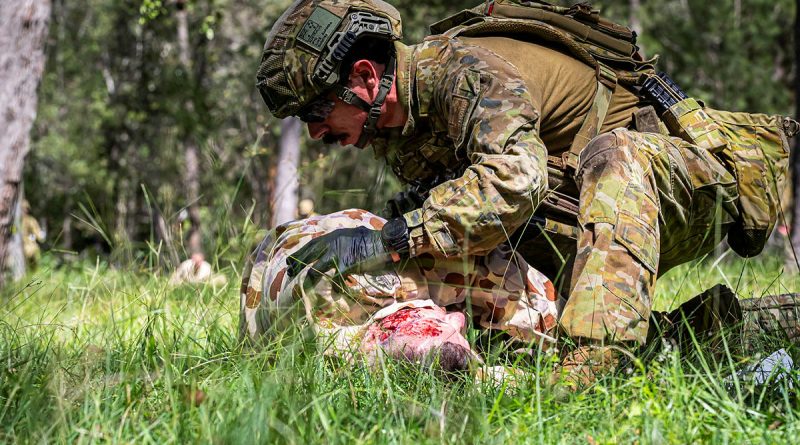Intense simulated injuries test medics

Screaming casualties pleaded for help as they clutched gunshot wounds.
CAPTION: An Army medic from 2nd Health Battalion gives emergency medical care to simulated casualties during Exercise Viper Walk. Story and photos by Corporal Melina Young.
Others appeared with shrapnel damage, burns and blast injuries – confronting 2nd Health Battalion (2HB) medics who scrambled to respond.
While the injuries were only simulated, they dramatically increased the level of realism as the battalion honed its battle wound treatment in preparation for a large-scale combat operations environment on Exercise Viper Walk.
More than 400 health professionals treated and transported patients in the battalion’s largest collective training exercise, held at Greenbank training area from March 4-18.
The first-of-its-kind combat health unit-level exercise had joint and international participation from the Royal Australian Air Force, New Zealand Defence Force and the United States military.
The training helped clinical personnel and commanders rehearse the land-based trauma system from point of injury to definitive care and rearward evacuation.
Clinicians were jolted into action on the first morning with 26 carefully crafted high-fidelity medical scenarios.
Intensity increased as the exercise progressed, with casualties continuously presenting at medical facilities to test triage, treatment and evacuation.
CAPTION: The art of moulage makeup is applied to simulated causalities to mimic injuries seen on the battlefield to dramatically increase the realism during clinical scenarios tested on Exercise Viper Walk 2024.
Starting with three and increasing to six simulated surgeries a day, role-players were swapped out of the operating theatre with cut suits and mannequins that sprayed fake blood if arteries weren’t clamped fast enough, and filled body cavities if surgical procedures weren’t executed fast enough.
The training aides were repaired and stitched back together multiple times a day, ready for the next incision.
Exercise Viper Walk allowed more amalgamation of SERCAT (service category) 5 and 7 (reservist) medics and paramedics to provide enroute care.
Commanding Officer 2HB Lieutenant Colonel Kelly Dunne said blending full and part-time medics in Exercise Viper Walk was crucial to the medical capability.
“An integrated workforce is key to success in ADF Health as we would not be able to generate the health capabilities we need without our SERCAT 5 specialists. Their expertise is fundamental to saving lives on the battlefield,” she said.
Simulated casualties received treatment from medics at the casualty clearing post before being moved to a Role 1 treatment team, or cared for by a brigade support platoon.
Once stabilised, patients were transferred to the Role 2E facility, featuring operating theatres, pathology, imaging, ICU, wards and pharmacy.
As simulated casualty numbers increased, crowding increased at the trauma deck within the hospital as ambulance after ambulance arrived with casualties needing triage.
CAPTION: Army clinicians from the 2nd Health Battalion perform surgery on a mannequin within the Role 2E health facility at Greenbank training area.
2HB also deployed a light, mobile Role 2 forward capability, which provided resuscitation and damage-control surgery to patients further forward on the battlefield.
Under the new health structure, 2HB brings together Army’s four health battalions.
The battalion is the largest health unit in the ADF, capable of exercising the entire land-based trauma system because of the specialised capabilities within the unit.
The exercise not only provided an opportunity to test and demonstrate 2HB’s readiness across all platforms, but it also showcased the unit’s work during a VIP day, with senior leadership teams representing various agencies, Defence industry, external clinical organisations and universities.
The exercise took more than six months to plan, and the clinical scenarios were designed to test all ranks and trades.
Throughout the course of the exercise, more than 100 medical and paramedic students from Queensland University of Technology participated as simulated casualties, complete with realistic moulage of traumatic injuries.
Dedicated senior clinical observer mentors were used to provide a completely immersive experience for exercise participants.
.
.

.
.







